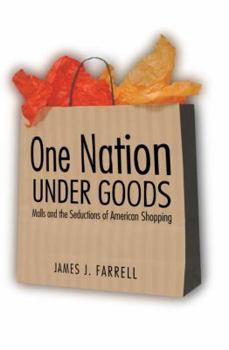One Nation Under Goods: Malls and the Seductions of American Shopping
Select Format
Select Condition 
Book Overview
Loved and hated, visited and avoided, seemingly everywhere yet endlessly the same, malls occupy a special place in American life. What, then, is this invention that evokes such strong and... This description may be from another edition of this product.
Format:Hardcover
Language:English
ISBN:1588341526
ISBN13:9781588341525
Release Date:September 2003
Publisher:Smithsonian Books (DC)
Length:329 Pages
Weight:1.35 lbs.
Dimensions:1.1" x 6.3" x 9.3"
Customer Reviews
3 ratings
One Nation Under Goods a Durable Good
Published by Thriftbooks.com User , 20 years ago
In One Nation Under Goods, Jim Farrell takes readers on a tour of American malls to discover the cultural patterns they display. As Farrell steers readers up escalators, he calls attention to the ways that shopping center executives plan the spaces of consumerism. As he parades them in front of dressing-room mirrors, he illustrates ways that consumer goods contribute to construction of identity. As he points out malls' potted plants, he reveals the processes through which shopping centers alter their ecological surroundings. Farrell notes in his introduction that American malls are variety stores-they sell a wide variety of goods to a vast diversity of people that make multiple meanings from those objects. One Nation Under Goods similarly provides a cornucopia of good ideas on American culture; it's a kind-of sales rack of ideas from which readers can pick and choose. It's even replete with intellectual display cases (tables, photos, and cartoons), that help provide opportunities to browse quickly for the most value-able concepts and lessons to be learned.Farrell's book, like the best mall merchandise, is neither out-of-date nor too faddish for scholars to take note. One Nation Under Goods provides an original and important perspective on the aesthetics, economics, ethics, and politics of American shopping malls. Three elements of the book that seem particularly successful and that, in combination, distinguish the book from others in its field: its emphasis on spatial analysis; its ability to communicate playfully difficult concepts in concrete terms; its challenge to create an ethical framework for American consumerism. First, I like the way that Farrell draws attention to the physical spaces of American malls. Malls take place-and Farrell asks readers to consider both the indoor and outdoor places transformed by shopping centers. Part of Farrell's success in illuminating indoor spaces comes from his close reading of documents overlooked by many mall scholars-the retail design manuals and marketing magazines that shopping center executives use to create retail spaces. Farrell also considers the environmental impacts of malls on water quality and indigenous vegetation and contemplates the ways in which mall-goers experiences shape the ways in which they conceptualize their spaces. As he notes, "It's interesting that the endangered species and ecosystems that are featured in the mall are not generally the ones we live in." The Mall of America in Bloomington, has a Rainforest Café, but he notes that it "doesn't have a Prairie Café, or a Corn-and-Soybeans Cabaret or a suburban Back-Yard Bistro." (238-239) By engaging in cultural and physical geography, Farrell's study recognizes how American values are embodied and sited in place.Secondly, Farrell skillfully uses concrete objects and instances to illustrate complex theories. You could say that Jim Farrell writes about Rainforest Café in One Nation Under Goods, and it's true, but only
The Value of Values in Shopping
Published by Thriftbooks.com User , 20 years ago
With good wit and numerous plays on words, Farrell reveals the implicit value statements of shopping and buying, exposing the price we pay (above the sticker) in consumer society. The book isn't anti-consumer, but points to the hidden costs of various purchases, such as the implicit acceptance of sweatshop labor in buying many brands of shoe or the acceptance of environmental degradation for buying paper. He's also effective at illustrating how, despite the American affinity for shopping, a doubling of our material possessions in the past 50 years has not made us any happier. A thoughtful and insightful look at the meaning of malls in the making of the American Dream.
Listened to the Minnesota Public Radio Interview
Published by Thriftbooks.com User , 21 years ago
I have not ordered the book yet. But I must say, I found the presentation and the interview by this author and professor to be one of the most balanced and insightful programs I have heard. The author introduced many ideas that I had not considered before in my life - like "How did you learn how to shop?" This author moves far beyond simplistic analysis of whether the phenomenon of the mall is good or bad for us. He provokes thinking and insights that reveal the core of what we value. He sums up his view of shopping and malls as being "about stories." According to the interview, we all want to ba a part of a story. The author calls for reflection and choices about the kinds of stories we want to be a part of and how to make choices to elevate our stories to benefit community and the planet. If the book is anything like the interview, I welcome this author's thoughts.





